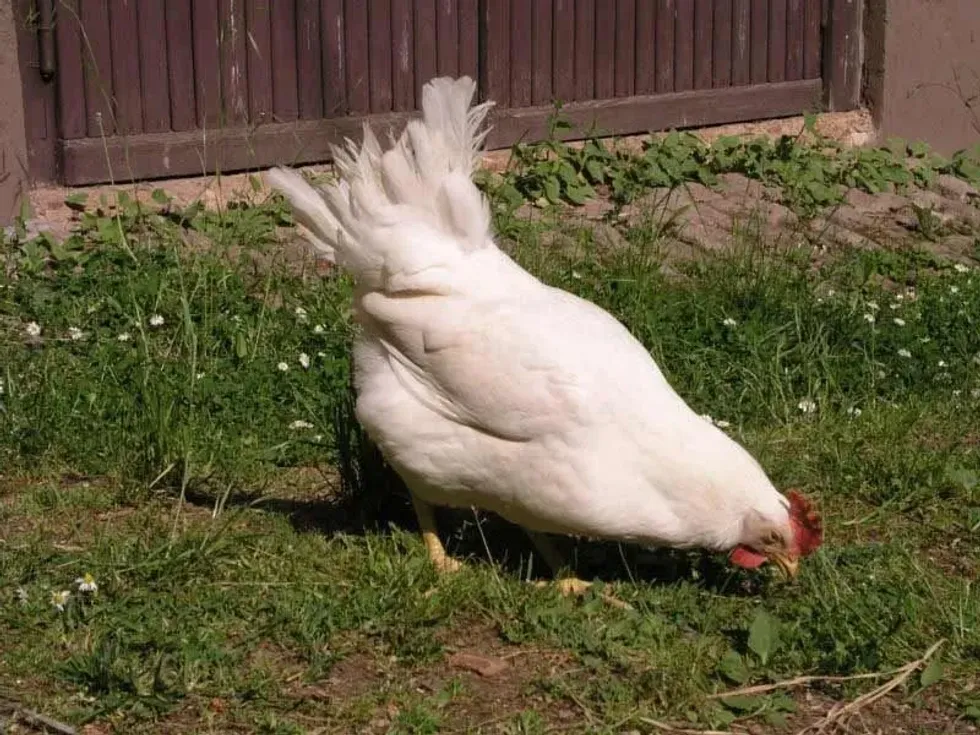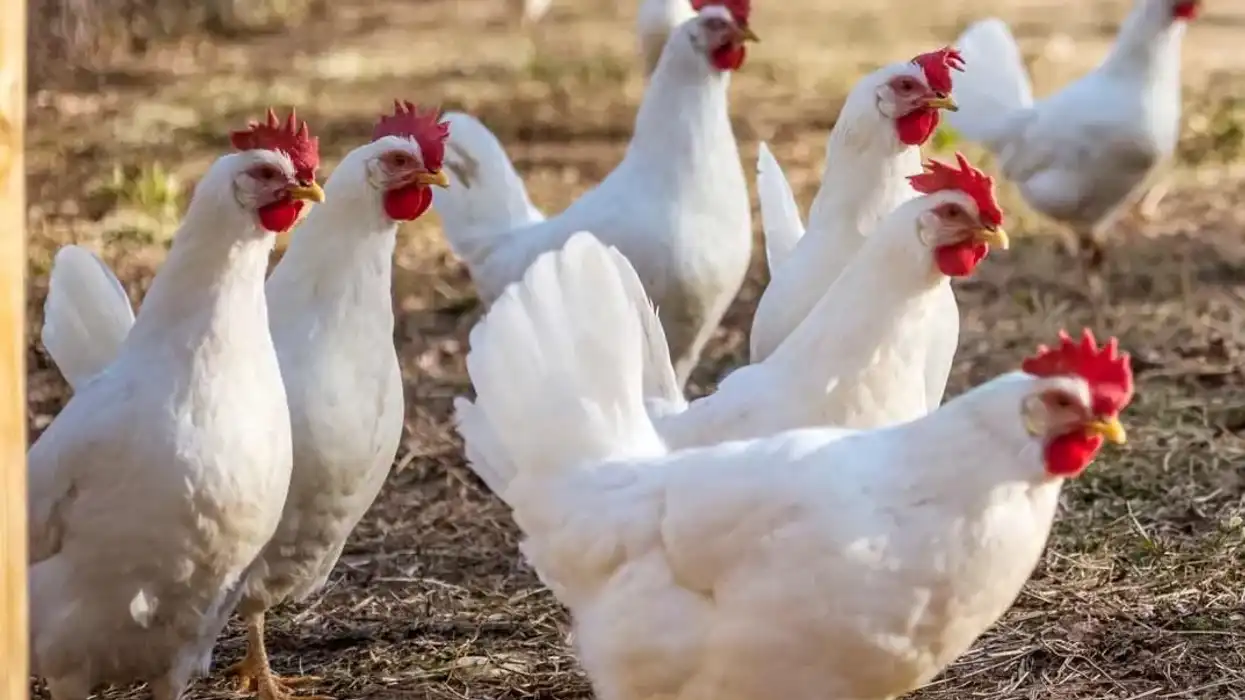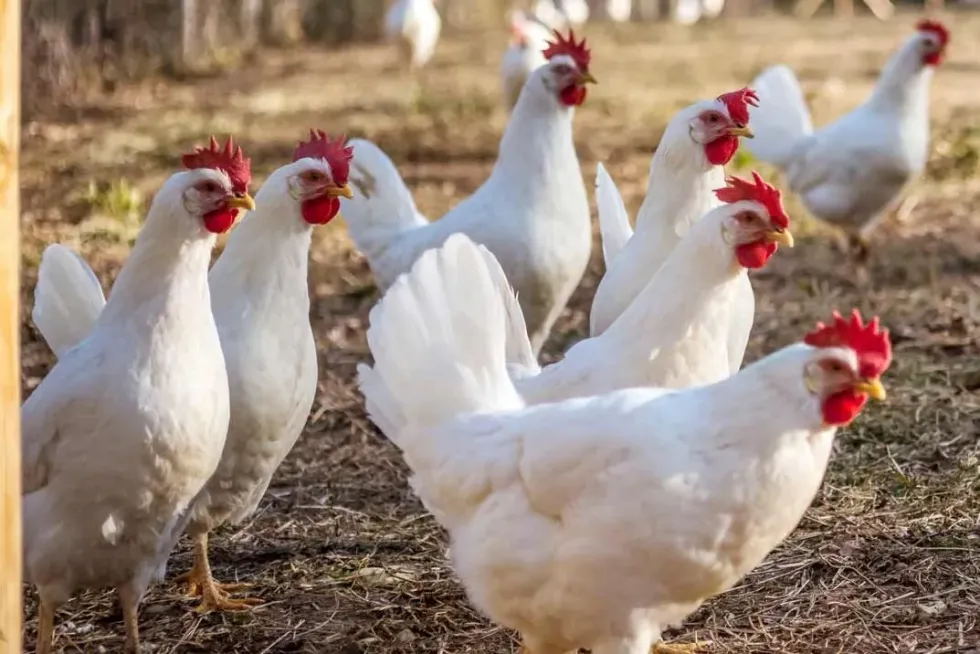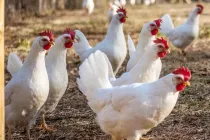Fun Leghorn Chicken Facts For Kids

Content
- What type of animal is a Leghorn Chicken?
- What class of animal does a Leghorn Chicken belong to?
- How many Leghorn Chickens are there in the world?
- Where does a Leghorn Chicken live?
- What is a Leghorn Chicken's habitat?
- Who do Leghorn Chickens live with?
- How long does a Leghorn Chicken live?
- How do they reproduce?
- What is their conservation status?
- What do Leghorn Chickens look like?
- How cute are they?
- How do they communicate?
- How big is a Leghorn Chicken?
- How fast can a Leghorn Chicken fly?
- How much does a Leghorn Chicken weigh?
- What are their male and female names of the species?
- What would you call a baby Leghorn Chicken?
- What do they eat?
- Are they dangerous?
- Would they make a good pet?
- Did you know...
- The Leghorn Chicken's eggs
- Having your own Leghorn Chickens
The White Leghorn Chickens are one of the most commonly found industrial chicken breeds and a favorite among the egg-laying community. Originally found in Tuscany this chicken breed was reportedly brought to North America in the year 1828.
They were then brought to the UK and other western countries at the end of the 1800s, where they stayed as a farmer's favorite These chickens have a highly energetic and aloof disposition and are not friendly towards humans.
This chicken breed is also famous for its rose comb and single comb varieties. Leghorn Chickens with a single comb are ideal for warmer climates whereas Leghorn Chickens with a rose comb is ideal for harsh winters in North American states.
In addition to their disposition, they are around in a variety of colors. So whether you are looking for pearl white Leghorn Chicken facts or brown Leghorn Chicken facts, we have you covered!
Read on all about the Leghorn Chicken breed facts - from their feed to egg, their black-tailed, red, large wattles, their egg color (white and cream), and so much more! If you enjoy reading about the Brown Leghorns and the White Leghorns, then you should also check out the prairie chicken and Guinea fowl. Happy reading!
Leghorn Chicken Interesting Facts
What type of animal is a Leghorn Chicken?
The White Leghorn Chickens are a type of bird, and more specifically, are types of chickens.
What class of animal does a Leghorn Chicken belong to?
White Leghorn Chickens belong to the class of birds (Aves).
How many Leghorn Chickens are there in the world?
Due to a lack of research, it is not possible to fixate on one number for the population of the White Leghorn Chicken. However, due to human demand, their population increases annually.
Where does a Leghorn Chicken live?
The White Leghorn Chicken lives on a farm or in an independent backyard.
What is a Leghorn Chicken's habitat?
A White Leghorn Chicken is an outdoor bird. This breed enjoys a spacious environment with shrubs and grasslands, with a moderate amount of water and places to coop and rest. They had originated in Italy, but now, are mostly found in the United States, U.K., and more.
Who do Leghorn Chickens live with?
These chickens usually live in independent flocks with one dominant male White Leghorn Chicken and several other White Leghorn hen.
How long does a Leghorn Chicken live?
A White Leghorn's life expectancy is usually more than five years. Though they are mostly domesticated breeds, their lifespan in the wild sees a marginal increase, with the oldest recorded specimens living up to seven years of age.
How do they reproduce?
The chickens do not reproduce in the conventional method of reproduction. They have an external office, which is called the cloaca.
The male and the female touch the cloaca together, and the male transfers the sperm to the female reproductive tract. The egg is then fertilized, and it is only eggs like this that can hatch into chicks and babies. Eggs that have not been fertilized will never hatch.
What is their conservation status?
According to the IUCN List, the White Leghorn Chicken is classified as Least Concern. There is a popular demand for these chickens and so their population is stable.
Leghorn Chicken Fun Facts
What do Leghorn Chickens look like?
It is interesting to note that these chickens are most commonly identified with white color, and large wattles even though they are found in a variety of colors such as black Leghorns, brown, red, silver, buff, and golden among others.
The Leghorn has a powerful set of wings that allows them to take flight and perch high up in the trees.
These chickens are also differentiated from one another by the comb they possess.
Rose comb Leghorns are usually bright red in color and are sized averagely. On the other hand, single comb Leghorns are bright red and are easily distinguished as they have five distinct points.
In male Leghorns, these distinct points stand out in an upright position. In Leghorn hens, there's only one distinct point that gives them a very slender and comical look.
These chicken breeds also have red wattles and white oval ear lobes. They have a good plumage that covers the whole body rendering the yellow skin invisible.
This chicken breed has a variety of colors when it comes to feet ranging from yellow, brown to off-white. They have either yellow or red-colored eyes and their beaks are usually yellow in color.

How cute are they?
These Leghorn chickens are not very cute to look at. They have small, fluffy bodies with yellow eyes and tall legs.
The Leghorns are certainly very sleek animals and bred to lay eggs, but since the breed does not enjoy human company, chances are, they will not be cute, or adorable to look at. However, some people have appreciated these wonderful birds for their pure white plumage and attractive colors.
How do they communicate?
The Leghorns will communicate with a variety of calls, squawks, coos, and caws. These will differ from the Leghorn hens to the Leghorn rooster, and whether they are looking to breed, to call to their chickens, about to lay their prolific white eggs, and more.
Apart from calls and sounds, they also have a lot of non-verbal sounds as well. They will flutter their wings, stamp their claws, peck with their beaks as well as circle around their enemies in order to assert dominance, fight for coop space, and claim mating rights.
How big is a Leghorn Chicken?
A Leghorn Chicken is relatively smaller than almost any other breed. They are 10-14 in tall, which is a third of the size of the Jersey Chicken (also the largest chicken breed in the United States).
If fed well, then they can grow significantly large, but not more than the average range for their species. Though they are still on the smaller end for egg-laying chickens, they are nevertheless accepted. However, their size may sometimes pose problems for adjustment with other, larger species of chicken who coop with them.
How fast can a Leghorn Chicken fly?
Leghorn chickens are excellent flyers and can clear a fence as tall as 10 m. Though they are not the fastest of chickens around, they should definitely not be underestimated. They can jump, run, roll, hop and even run around coops very fast.
This is a quality that is equivalent across White Leghorns as well as the Brown Leghorn. Hence, it is advised to clip their wings or train them to live in coops so that they get used to space and to stop them from perching in trees.
How much does a Leghorn Chicken weigh?
A White Leghorn Chicken typically weighs from 4.5-7 lb. This makes them on the lighter side of Leghorns.
Though some will claim that the Leghorns also have the dual purpose of being used as table meat, these chicken breeds are far too slim and do not have enough meat on their bones for this purpose.
Therefore, though they have the perfect weight to be egg-laying birds, and they can not be particularly useful as table meat or for consumption purposes.
What are their male and female names of the species?
Both Leghorn rooster and Leghorn hen have no particular name as such, but if you ever adopt one, you can give the Leghorn a name they will love. This species, however, was not always called the Leghorn.
Originating from Italy, they were originally called the 'Livornio'. Livornio is the city from where these wonderful chickens are said to have originated.
What would you call a baby Leghorn Chicken?
A baby White Leghorn Chicken is called a chick. These Leghorn chicks are hatched in approximately two weeks' time, after which they grow into adult Leghorns in almost no time at all. They reach adulthood in less than four months, and can start laying around 300 eggs per year as young as five months old!
What do they eat?
The Leghorn Chicken is very low-maintenance and loves foraging because of its independent nature. When left on their own they love eating slugs, beetles, grains, and plant seeds. However, people who are planning to keep these chickens must take into account their capacity to lay eggs and provide proper feed and calcium supplements, and grit for better egg production.
They should also be discouraged from eating slugs in particular, because that disrupts their body hormones, and may not produce high-quality eggs. If you do not wish to have a feeding trough for them, then you can simply scatter food around their plot. They will enjoy the search, and keep busy and entertained throughout the day.
Are they dangerous?
These chickens even though flighty, nervous, and loud, are usually adaptable, but if they are kept together with male cockerels then they tend to get aggressive and dangerous. So usually, no. The Leghorn Chicken is a danger to no one provided they are cared for well.
However, it is still advised that the males and females of this species should be kept apart. This is because breeding season brings with them unwanted aggression and energy.
Already high strung animals, the mating season drives them to extreme levels of pent-up enthusiasm, which can not only hurt other coop-mates, but also destroy property, prevent the hens from laying eggs, and cause general disruption.
Would they make a good pet?
Leghorns wouldn't make a good pet as they are very flighty, aloof, and independent. Therefore, they aren't very welcoming of human contact.
However, it has been seen that people who rear them as chicks are able to tame them when they become adults.
White Leghorns and the Brown Leghorn are the most popular chicken breeds for this purpose because while they may not be a very friendly breed, these birds get the job done, and will lay an ample number of eggs.
Therefore, anyone who wishes to have them as pets will have to work around their abrasive, aloof nature, independent streak, and aversion to human contact. However, on second thoughts, you should reconsider keeping them as anything more than farm animals.
Keeping this breed as pets does not serve any useful purpose to those who rear them, apart from maybe a healthy supply of eggs.
Did you know...
The Leghorn hen might be an excellent egg-layer, but they are terrible brooders. Their high energy levels ensure that the hens never stay in the same place for too long.
This means that as soon as they lay eggs, the hens will walk away, abandoning their eggs and never actually brooding on them. Farmers who wish for the eggs to hatch into chicks then have to place them in an incubator.
If they do not want the egg hatched, they can simply collect it from the birds' nest every morning.
Often, farmers will get creative and place their eggs in the nests of other chicken breeds, who may not lay as many eggs, but are excellent brooders. They spend entire days brooding on the eggs, resulting in the early hatching of chicks.
In fact, this chicken is such an integral part of American memory, that the 1900s running of the popular show Tom and Jerry featured a Leghorn Chicken called Foghorn Leghorn.
This Leghorn prominently featured in the show, with quotes such as: “As senior rooster ’round here, it’s my duty, and my pleasure, to instruct junior roosters in the ancient art of roostery.” and “Hey boy, what’s the idea jackin’ that pot up under me?
Jack? Pot? Ahuh, huh … jack pot, that’s a joke son, don’t ya get it?”
The Leghorn Chicken's eggs
The White Leghorn lays white eggs, and the egg production is as often as two to four weeks, producing around 280-320 eggs per year. The White Leghorn can start laying eggs from as early as about 4.5-5 months old.
This prolific egg-laying capacity has made them a favorite on any farm.
When the light enters the hens' eye it activates a photosensitive gland known as the pineal gland which is positioned nearby the eye. This triggers a response that sends a message to release the egg from the hen's ovary thereby prompting the hens to lay eggs.
The White Leghorn will only lay one egg per day since laying eggs is dependent on the amount of sunlight received by them.
The Leghorn chickens are kept in well-lit coops and provided with artificial lighting during the winter months to facilitate egg production. Eggs can be laid even in the absence of a Leghorn rooster but fertilization of the eggs to give rise to Leghorn chicks requires the presence of a male rooster.
After fertilization, it takes two weeks for the eggs to hatch and the chickens to emerge.
Having your own Leghorn Chickens
The Leghorns as a breed are a wonderful addition to your home, even though they do not enjoy human company.
With some steps, you too can create a farm where these birds will be happy to breed, lay eggs, and rear chicks. The first step is setting up a large area, away from urban landscapes, with lots of water, space to roam and roost.
These birds are very high fliers, so it would be a good idea to keep a tall fence or clip their wings when they are chicks.
The enclosure of the White Leghorn needs to be maintained daily, and the males and females of this breed should be kept strictly apart (except when wanting fertilized eggs for chicks), as cross-contact makes the males aggressive.
They do not cost a lot, standard pricing being around $4 (USD) for Leghorn chicks, and around $7 (USD) for an adult White Leghorn.
They are a hardy breed, which produces a lot of eggs and chicks, do not require a lot of food or care, and in general, are independent and low maintenance. It is a good idea to keep food available at all times and change the feeding throughs once every two days.
Even though they can forage for food on their own, the readily available grain will make them more likely to breed and lay eggs.
And that is all! With these few small steps and regular checks to ensure that there is no disease or infection in your chicks or breeds, you are officially good to go as a White Leghorn owner.
Here at Kidadl, we have carefully created lots of interesting family-friendly animal facts for everyone to discover! Learn more about some other birds including Cooper's hawk, or barn owl.
You can even occupy yourself at home by drawing one on our Leghorn Chicken coloring pages.
We Want Your Photos!
More for You
See All
Bachelor of Arts specializing in English Language, Master of Philosophy

Devangana RathoreBachelor of Arts specializing in English Language, Master of Philosophy
Devangana is a highly accomplished content writer and a deep thinker with a Master's degree in Philosophy from Trinity College, Dublin. With a wealth of experience in copywriting, she has worked with The Career Coach in Dublin and is constantly looking to enhance her skills through online courses from some of the world's leading universities. Devangana has a strong background in computer science and is also an accomplished editor and social media manager. Her leadership skills were honed during her time as the literacy society president and student president at the University of Delhi.
Bachelor of Business Management

Yashvee PatelBachelor of Business Management
Yashvee has won awards for both her writing and badminton skills. She holds a business administration honors degree and has previously interned with social media clients and worked on content for an international student festival. Yashvee has excelled in academic competitions, ranking in the top 100 in the Unified International English Olympiad and placing second in an essay-writing competition. Additionally, she has won the inter-school singles badminton title for two consecutive years.
Disclaimer
1) Kidadl is independent and to make our service free to you the reader we are supported by advertising. We hope you love our recommendations for products and services! What we suggest is selected independently by the Kidadl team. If you purchase using the Buy Now button we may earn a small commission. This does not influence our choices. Prices are correct and items are available at the time the article was published but we cannot guarantee that on the time of reading. Please note that Kidadl is a participant in the Amazon Services LLC Associates Program, an affiliate advertising program designed to provide a means for sites to earn advertising fees by advertising and linking to Amazon. We also link to other websites, but are not responsible for their content.
2) At Kidadl, we strive to recommend the very best activities and events. We will always aim to give you accurate information at the date of publication - however, information does change, so it’s important you do your own research, double-check and make the decision that is right for your family. We recognise that not all activities and ideas are appropriate for all children and families or in all circumstances. Our recommended activities are based on age but these are a guide. We recommend that these ideas are used as inspiration, that ideas are undertaken with appropriate adult supervision, and that each adult uses their own discretion and knowledge of their children to consider the safety and suitability. Kidadl cannot accept liability for the execution of these ideas, and parental supervision is advised at all times, as safety is paramount. Anyone using the information provided by Kidadl does so at their own risk and we can not accept liability if things go wrong.
3) Because we are an educational resource, we have quotes and facts about a range of historical and modern figures. We do not endorse the actions of or rhetoric of all the people included in these collections, but we think they are important for growing minds to learn about under the guidance of parents or guardians.







